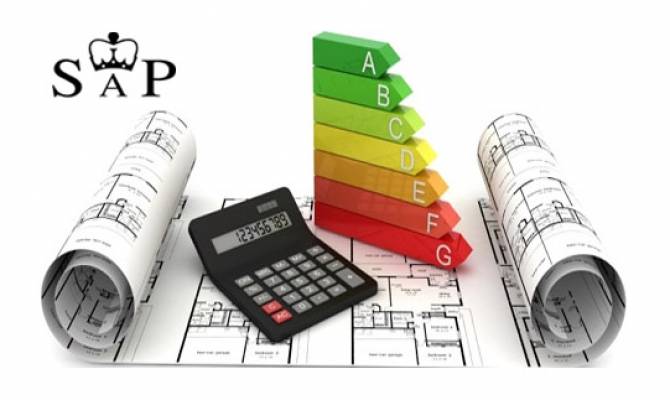What Are SAP Calculations? The Ultimate Guide

What Are SAP Calculations?
So, what are SAP calculations? SAP stands for ‘Standard Assessment Procedure’ and is the government’s method for calculating the energy performance of dwellings.
These calculations are only necessary for residential properties. In England, your SAP calculations measure two elements; the Dwelling Emission Rate (DER) and Dwelling Fabric Energy Efficiency (DFEE).
The calculations determine a Target Emissions Rate (TER) and a Target Fabric Energy Efficiency (TFEE) rate. The DER and DFEE must be lower than the TER and TFEE. In Wales and Scotland, the report only measures the DER – although building regulation standards are stricter.
SAP calculations come in two formats; L1A (new builds) and L1B (extensions and conversions). The primary purpose of the calculations is to produce a new or updated Energy Performance Certificate (EPC).
Why Do I Need SAP Calculations?
The calculations are required by Part L (England & Wales), Section 6 (Scotland), Part F1 (Northern Ireland) of building regulation standards. These documents are concerned with the conservation of fuel and power. Since their introduction in 1995, these regulations have been amended several times in line with the availability and effectiveness of new technologies. You need to carry out these calculations in order to produce a new or up-to-date Energy Performance Certificate (EPC). An EPC is required by law to rent or sell a residential property. The EPC rates the property between a G (worst performance) to an A (best) across two measures – energy efficiency rating and environmental impact rating. From 1st April 2018, it was against the law to rent a property with an F or G rating in either category.
How Are SAP Calculations Completed?
- In order for our team to carry out calculations, the customer should provide as much information as possible.
This includes, but is not limited to: - Floorplans
- Elevations
- Sections
- Site Plan
- Insulation type/thickness
- U-value of openings
- Specification of heating systems
- Hot water generation
- Percentage of low energy lighting
- Specification of ventilation system
- Renewable technologies
- Accredited construction details
How your SAP calculations are carried out will depend on whether your project is a new build, or an extension or conversion. In either instance, the calculations are divided into two reports: L1A SAP & L1B SAP:
L1A SAP Calculations Information
For new builds, your SAP calculations will be divided into two reports: ‘design stage’ and ‘as built’.
Design Stage Report
- Before construction begins, our team will assess and approve the construction details of the property.
- This data is input into calculation software in order to produce TER and TFEE rates and to demonstrate that the building is DER and DFEE compliant.
- A ‘predicted energy assessment’ is produced.
As Built Report
- Once the building is complete, the construction details are re-assessed and any final details included, such as boiler model or air tightness score.
- This final report produced the EPC.
L1B SAP Calculations Information
- Our team will assess the construction details of the entire property, plus the proposed extension or conversion. From this, they will create a report with benchmarked data.
- To create the report, the construction detail data is input into SAP calculations software in order to produce notional TER and TFEE rates and DER and DFEE measurements.
- The proposed report will use the benchmarked data for existing elements. For any new or upgraded elements, our team will assess the actual performance data.
- This data is then input into SAP calculations software in order to produce the proposed TER and TFEE rates and DER and DFEE measurements.
- The performance values of the proposed elements must be lower than the benchmarked standards in order for the property to pass.
- In addition to this, the overall DER and DFEE measurements must be lower in the proposed report than in the notional report.
- If the building's SAP calculations demonstrate that the building’s performance values are all lower in the proposed report than the notional report, a new EPC is produced, replacing the property’s existing EPC.
L1B SAP Calculations for extensions and conversions are divided into ‘notional’ and ‘proposed’.
Notional Report
Proposed Report
When Should An SAP Calculation Be Carried Out?
You should carry out SAP calculations before building work starts. This is so at design stage, you can be confident that the plans and specifications will achieve a pass. In the case of L1A SAP calculations, a second report will need to be produced once the building has finished.
How Long Will The SAP Calculation Take?
This entirely depends on the timeline of your construction project. Generally, UKBC aims to complete all reports within 5–10 working days after request.
What Happens If My Building Fails?
It is against the law to rent or sell a property without an EPC. Therefore, it is crucial that your building passes its SAP. It is very important to arrange your SAP calculations before building work commences, so that should the building be failing to meet building regulation standards, our SAP assessors can give you advice on how to improve. This becomes more difficult and expensive later in the project, as the scope of changes available becomes more limited. UKBC aims to provide comprehensive support and guidance throughout the entire SAP process. Whereas many companies will only carry out the calculations, UKBC provide our clients with a consultancy service to make sure our customers have the information and advice they need to pass the SAP.
Share
